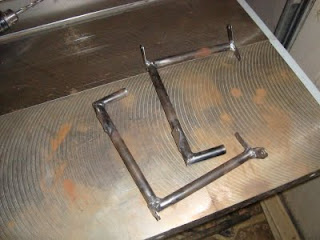We had quite the cold snap here in the north west and heating the shop to acceptable temperatures had been futile until late last week. With the help of a couple of heaters I managed to get the shop warmed up enough to do some layups.
Here is the inside of the center section spar with the internal glass plies and bulkheads. In this photo the top of the spar is on the right. The bottom, on the left, has a slight dihedral. The aft face is down and the forward face is up. In the right background is pictured the 3 panels, glassed on the inside surface, that will be the forward face of the spar.
Here is another picture of the 3 forward panels ready to micro in place.
Here pictured is the spar after the forward face has been bonded in place and the spar cap troughs have been carved.
Pictured here are the 6 1/4" attachment point reenforcement pieces. Each of these locations will later be drilled to receive 1/2" bolts attaching the wings to this center spar.





















































